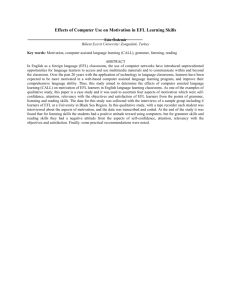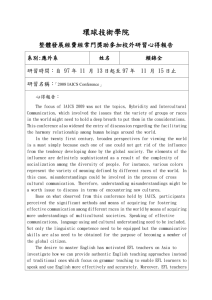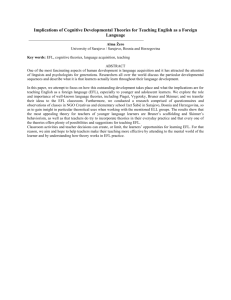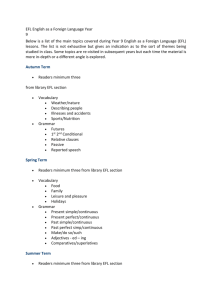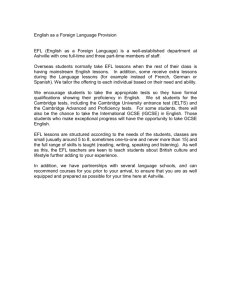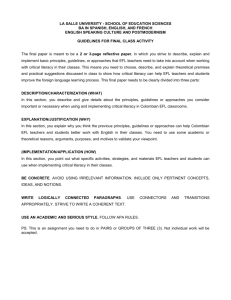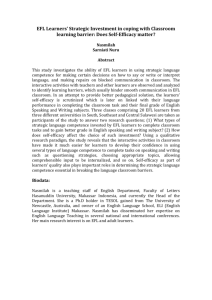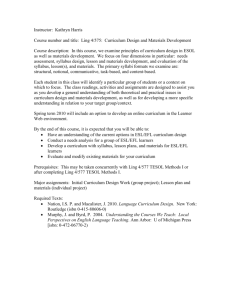11: 15 – 11: 45
advertisement
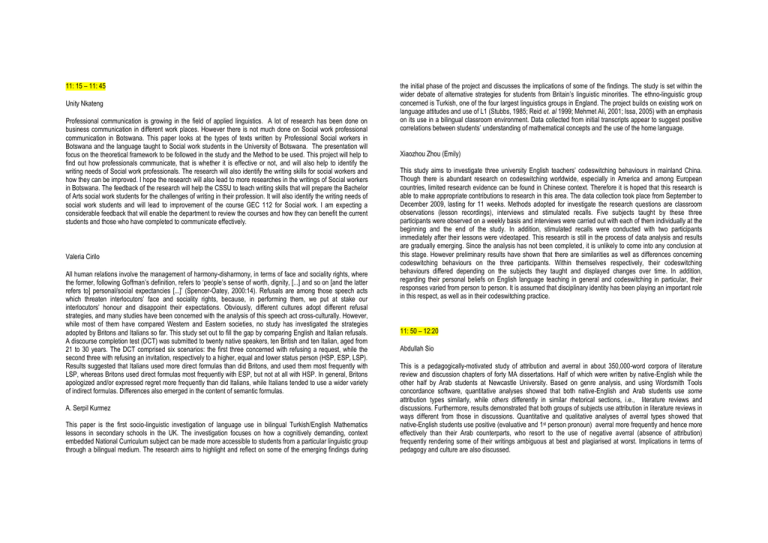
11: 15 – 11: 45 Unity Nkateng Professional communication is growing in the field of applied linguistics. A lot of research has been done on business communication in different work places. However there is not much done on Social work professional communication in Botswana. This paper looks at the types of texts written by Professional Social workers in Botswana and the language taught to Social work students in the University of Botswana. The presentation will focus on the theoretical framework to be followed in the study and the Method to be used. This project will help to find out how professionals communicate, that is whether it is effective or not, and will also help to identify the writing needs of Social work professionals. The research will also identify the writing skills for social workers and how they can be improved. I hope the research will also lead to more researches in the writings of Social workers in Botswana. The feedback of the research will help the CSSU to teach writing skills that will prepare the Bachelor of Arts social work students for the challenges of writing in their profession. It will also identify the writing needs of social work students and will lead to improvement of the course GEC 112 for Social work. I am expecting a considerable feedback that will enable the department to review the courses and how they can benefit the current students and those who have completed to communicate effectively. Valeria Cirilo All human relations involve the management of harmony-disharmony, in terms of face and sociality rights, where the former, following Goffman’s definition, refers to ‘people’s sense of worth, dignity, [...] and so on [and the latter refers to] personal/social expectancies [...]’ (Spencer-Oatey, 2000:14). Refusals are among those speech acts which threaten interlocutors’ face and sociality rights, because, in performing them, we put at stake our interlocutors’ honour and disappoint their expectations. Obviously, different cultures adopt different refusal strategies, and many studies have been concerned with the analysis of this speech act cross-culturally. However, while most of them have compared Western and Eastern societies, no study has investigated the strategies adopted by Britons and Italians so far. This study set out to fill the gap by comparing English and Italian refusals. A discourse completion test (DCT) was submitted to twenty native speakers, ten British and ten Italian, aged from 21 to 30 years. The DCT comprised six scenarios: the first three concerned with refusing a request, while the second three with refusing an invitation, respectively to a higher, equal and lower status person (HSP, ESP, LSP). Results suggested that Italians used more direct formulas than did Britons, and used them most frequently with LSP, whereas Britons used direct formulas most frequently with ESP, but not at all with HSP. In general, Britons apologized and/or expressed regret more frequently than did Italians, while Italians tended to use a wider variety of indirect formulas. Differences also emerged in the content of semantic formulas. A. Serpil Kurmez This paper is the first socio-linguistic investigation of language use in bilingual Turkish/English Mathematics lessons in secondary schools in the UK. The investigation focuses on how a cognitively demanding, context embedded National Curriculum subject can be made more accessible to students from a particular linguistic group through a bilingual medium. The research aims to highlight and reflect on some of the emerging findings during the initial phase of the project and discusses the implications of some of the findings. The study is set within the wider debate of alternative strategies for students from Britain’s linguistic minorities. The ethno-linguistic group concerned is Turkish, one of the four largest linguistics groups in England. The project builds on existing work on language attitudes and use of L1 (Stubbs, 1985; Reid et. al 1999; Mehmet Ali, 2001; Issa, 2005) with an emphasis on its use in a bilingual classroom environment. Data collected from initial transcripts appear to suggest positive correlations between students’ understanding of mathematical concepts and the use of the home language. Xiaozhou Zhou (Emily) This study aims to investigate three university English teachers’ codeswitching behaviours in mainland China. Though there is abundant research on codeswitching worldwide, especially in America and among European countries, limited research evidence can be found in Chinese context. Therefore it is hoped that this research is able to make appropriate contributions to research in this area. The data collection took place from September to December 2009, lasting for 11 weeks. Methods adopted for investigate the research questions are classroom observations (lesson recordings), interviews and stimulated recalls. Five subjects taught by these three participants were observed on a weekly basis and interviews were carried out with each of them individually at the beginning and the end of the study. In addition, stimulated recalls were conducted with two participants immediately after their lessons were videotaped. This research is still in the process of data analysis and results are gradually emerging. Since the analysis has not been completed, it is unlikely to come into any conclusion at this stage. However preliminary results have shown that there are similarities as well as differences concerning codeswitching behaviours on the three participants. Within themselves respectively, their codeswitching behaviours differed depending on the subjects they taught and displayed changes over time. In addition, regarding their personal beliefs on English language teaching in general and codeswitching in particular, their responses varied from person to person. It is assumed that disciplinary identity has been playing an important role in this respect, as well as in their codeswitching practice. 11: 50 – 12:20 Abdullah Sio This is a pedagogically-motivated study of attribution and averral in about 350,000-word corpora of literature review and discussion chapters of forty MA dissertations. Half of which were written by native-English while the other half by Arab students at Newcastle University. Based on genre analysis, and using Wordsmith Tools concordance software, quantitative analyses showed that both native-English and Arab students use some attribution types similarly, while others differently in similar rhetorical sections, i.e., literature reviews and discussions. Furthermore, results demonstrated that both groups of subjects use attribution in literature reviews in ways different from those in discussions. Quantitative and qualitative analyses of averral types showed that native-English students use positive (evaluative and 1st person pronoun) averral more frequently and hence more effectively than their Arab counterparts, who resort to the use of negative averral (absence of attribution) frequently rendering some of their writings ambiguous at best and plagiarised at worst. Implications in terms of pedagogy and culture are also discussed. Li Sui Sum Bosco The present study examines the meeting discourse with the aim of exploring how interlocutors use the English language to communicate with each other in intercultural workplace settings in Hong Kong. In Hong Kong, it is quite common for schools and educational institutes employ both the locals and English expatriates to teach the English subject and the composition of these practitioners is highly multicultural. English is very often used as a lingua franca among practitioners. As a result, the respective discourse in English has been chosen as the focus of this research. The present research is based on the theoretical framework of rapport management proposed by Spencer-Oatey (2000). Spencer-Oatey’s framework is an expanded framework based on politeness theory (Brown & Levinson, 1987). Spencer-Oatey suggested that the term ‘rapport’ should be used instead of ‘politeness’ and two motivational forces underlying the management of relations were maintained including face and sociality rights. The present study examines how people from different cultures and with different first languages interact and communicate with each other in workplaces with reference to the expanded framework of rapport management. This research focuses on two discursive aspects including 1) meeting management, which is more transactional in nature, and 2) the use of humour, which is more relational. Maritza Rosas Maldonado Communication Strategies (CSs) refer to the different mechanisms L2 learners apply to overcome the difficulties they encounter in communicating. Research in this area, although extensive, has not thoroughly examined CSs in interactional contexts and has focused mainly on lexical problems and English as L2. This paper reports on work in progress which focuses on the CSs that Spanish L2 learners apply in face-to-face interactions with other learners (NNSs) and native speakers (NSs) of Spanish. A task methodology was designed so that dyads of NNSNNS and NNS-NS are observed as they interact through the carrying out of two communicative tasks in a laboratory setting. The collection of data therefore involves video and audio recording, personal observation of participants’ interactions and stimulated recall after such interactions. The aim is to gather data on the number and types of CSs used, the extent to which the CSs vary in accordance to the interlocutor and the tasks performed, and the extent to which the interlocutor and the task influence the learners' interactional moves through their use of interactional CSs. In this paper, I will present the methodology used for the data elicitation as well as for the analysis. A further aim will be to present some preliminary findings in relation to the quantity and type of CSs used. Fiona Willians Many postcolonial nations struggle to implement language-in-education policies that simultaneously engender effective learning, are contextually relevant for the nation’s citizens, and enable greater participation in the increasingly global world. Debates over such policies often place former colonial languages in opposition to local languages. However, Vanuatu’s situation is further complicated by a unique colonial past, in which the islands were ruled jointly by Britain and France. Today’s education system is an obvious example of this legacy, as two thirds of schools are English-medium while the remaining third are French-medium. Two issues have been debated in Vanuatu during the thirty years since independence: Firstly, calls have been made for early education to be carried out through the medium of the mother tongue, before transition to one of the European languages. At the same time, a variety of suggestions have been put forward as to how to combine the English-medium and French-medium streams into a single education system. To date, no effective change has been implemented. This paper will argue that the implementation of effective language-in-education policies is hindered by the lingering Anglo-French tensions from the colonial period. The ideological configuration underlying potential changes to the education system will first be summarised, before the ethnographic case study that is being conducted in order to investigate these issues empirically is outlined. 12:25 – 12:55 Ibrar Butt This paper is based on ongoing research investigating important differences in writing processes across paperbased and computer-based modes, using ‘think-aloud protocols’ (TAPs) as a data collection technique. A sequential mixed-methods study design is proposed in which research participants complete equivalent writing tasks in each mode, with TAPs analysed quantitatively and qualitatively. This is achieved by a thorough transcription of the TAPs, their categorisation (apropos planning, revising, evaluating, editing, etc.), and statistical analysis of their frequencies. This is followed by a discussion of subjects’ TAPs using transcribed verbatim extracts. My prior research with undergraduate EFL participants revealed that, on computer, writers did proportionately less pre-planning. An enmeshing of the planning and editing stages of writing was also visible on the computer, pointing towards a fundamental, if subtle, change of mental and physical approach to given tasks. A current PhD study seeks to explore these phenomena with an undergraduate mix at the University of Bradford. The presentation aims to set out the planned research programme, explain its significance, and identify key issues. It is argued that etic and emic analyses of TAPs would allow for a greater level of theoretical analysis (e.g. a metaanalysis) to take place; TAPs as verbal data are far too rich to offer a mere etic or emic analysis. In this respect, TAPs can be used by researchers with a positivist orientation, excluding immediate meanings of utterances from research interest; and also by nonpositivist researchers, where meanings of subjects’ protocols are central. Nathan Stinnette Addressing global sustainability challenges will require intercultural cooperation on an unprecedented scale. Multinational rganizations are key actors that need to move towards sustainability if society as a whole is to do so, but they face challenges in engaging their employees, who may come from many different countries and cultural backgrounds. More effective management of cultural issues around sustainability engagement within multinationals will allow them to benefit from their employee’s talents, skills and creativity as they transition towards a more sustainable future. By identifying a set of values implicit in sustainable development and their relationship to national culture values, the authors develop broad categories of success factors for supporting intercultural sustainability engagement. Within these categories, specific strategies and actions leading to successful engagement are identified. These are based on survey results and 19 interviews with sustainability practitioners and intercultural management experts. An extensive literature review contributes to a conceptual framework for studying the relevance of cultural differences to sustainability engagement and provides additional support for the research findings. The authors incorporate strategies they identified for successful intercultural sustainability engagement into a guidebook, intended to help practitioners working to engage employees of multinationals culturally adapt their approach for their target audiences. This guide is validated and refined by feedback from expert practitioners and consultants and then made available for general use. Ozgul Ozbak This study looks at the orientation and motivation types of Turkish EFL learners at tertiary level from a socioeducational model and self-determination theory perspectives. The literature has reported the use of an integrative-instrumental orientation dichotomy and extrinsic-intrinsic motivation dichotomy interchangeably. However, it is quite possible to see instances where integrative and instrumental orientations stem from either extrinsic or intrinsic sources. (Brown,2000). Therefore, although the two dichotomies look somewhat similar to each other indeed they are not identical (Oxford, 1996) and their investigation separately would be more fruitful to gain a better understanding of the issue. Within this perspective, the present study aims to address the following research questions: What kind of orientation do Turkish university EFL students have? What kind of motivation do they have? Does integrativeness appear in the Turkish EFL setting? Although this exploratory study is descriptive and qualitative, both quantitative and qualitative methods were employed. Forty Turkish university students were given questionnaires followed by semi-structured group interviews for twenty. The questionnaire findings showed that Turkish students have both extrinsic and intrinsic motivation with the former stronger than the latter. Similarly, both instrumental and integrative orientations were found to be adopted by Turkish learners with the instrumental one being the primary concern. The findings from the interviews revealed that although integrativeness is present in the Turkish EFL setting, it is principally related to integration into the English speaking global world and English speaking academia. Abdullah Alghamdi This qualitative study investigates the beliefs and practices that ESP and content area practitioners hold when teaching technical vocabulary in a Saudi Arabian industrial college. In addition to the common domestic complaint among practitioners that teaching technical words can be problematic, the central motive of this work is twofold. Firstly, who should teach technical vocabulary items in an industrial domain i.e., whether it is the job of ESP teachers or content area ones (e.g., Spack 1988, Esteban & Martos 2002) or it is the task of both parties (e.g., Nation 2001, Dudley-Evans & St John1998, Tabtabaei 2007). Secondly, how technical vocabulary items should be taught i.e., direct versus indirect linguistic and scientific techniques that practitioners usually employ in order to obtain their goal(s) (e.g., Nation 2001, Gairns & Redman 1986, Allen 1983). These issues were examined through the following research questions: Do ESP and content area practitioners hold the same beliefs on how to teach technical vocabulary and who should teach them? Are there any similarities between ESP and content area practitioners in their teaching of technical vocabulary items? Are there any within-group differences among ESP and content area teachers in their teaching of technical vocabulary items? Do ESP and content area practitioners’ beliefs match their actual classroom practices? Methodologically, six ESP and six subject practitioners in three different subjects i.e., (electronics, mechanics and management) were pre- interviewed, observed and postinterviewed over almost a full semester at the college. Semi-structured interviews and observations followed by document analysis. The initial findings of data analysis and interpretation shed light on the extent to which practitioners view technical vocabulary teaching as a problematic issue, the similarities/differences of the techniques used by both types of practitioners, the practitioners’ views on who should teach this type of vocabulary and finally, the congruence/incongruence between the practitioners’ stated beliefs and their actual classroom practices. 14:00 – 14:30 Pei Chun Liu This qualitative study investigates the beliefs and practices that ESP and content area practitioners hold when teaching technical vocabulary in a Saudi Arabian industrial college. In addition to the common domestic complaint among practitioners that teaching technical words can be problematic, the central motive of this work is twofold. Firstly, who should teach technical vocabulary items in an industrial domain i.e., whether it is the job of ESP teachers or content area ones (e.g., Spack 1988, Esteban & Martos 2002) or it is the task of both parties (e.g., Nation 2001, Dudley-Evans & St John1998, Tabtabaei 2007). Secondly, how technical vocabulary items should be taught i.e., direct versus indirect linguistic and scientific techniques that practitioners usually employ in order to obtain their goal(s) (e.g., Nation 2001, Gairns & Redman 1986, Allen 1983). These issues were examined through the following research questions: Do ESP and content area practitioners hold the same beliefs on how to teach technical vocabulary and who should teach them? Are there any similarities between ESP and content area practitioners in their teaching of technical vocabulary items? Are there any within-group differences among ESP and content area teachers in their teaching of technical vocabulary items? Do ESP and content area practitioners’ beliefs match their actual classroom practices? Methodologically, six ESP and six subject practitioners in three different subjects i.e., (electronics, mechanics and management) were pre- interviewed, observed and postinterviewed over almost a full semester at the college. Semi-structured interviews and observations followed by document analysis. The initial findings of data analysis and interpretation shed light on the extent to which practitioners view technical vocabulary teaching as a problematic issue, the similarities/differences of the techniques used by both types of practitioners, the practitioners’ views on who should teach this type of vocabulary and finally, the congruence/incongruence between the practitioners’ stated beliefs and their actual classroom practices. Kamsilawati Kamlun This paper attempts to present a general overview of Reader Response Theory including its nature as well as its highlights. These are appropriate and relevant for my study on the contemporary issue of literary response in L1 as well as in L2. The aim of this study is to investigate literary reading and responses in L1 and L2 by pre-service teachers in Malaysia. A number of researchers in the field of literature and language teaching and learning have argued that the reader response approach has considerable potential in similar field above (Hall, 2005; Miall & Kuiken, 1994; and Hanauer, 1995). However, although empirical research has been conducted to date to determine how reading in the literature and language class affects the students’ attitude towards it and how it affects students’ reading in L1 and L2 using different approaches and methodology, very little has been done to investigate how reading might influence engagement in a literary text by responding to the text aesthetically and critically. The development of Reader Response Theory is discussed from different perspectives mainly through the eyes of Louise Rosenblatt, Wolfgang Iser, Stanley Fish and other theorists. This is followed by reviews of the literature on student responses to literary texts in L1 as well as L2 and their influence on attitude and engagement toward reading which clearly show that such studies are within the framework discussed. Finally, this paper will present the research questions pertaining to the issues that emerge in specific educational contexts which, in my case, is the Malaysian context. Yi-chun (Sherri) Wei This presentation will focus on the role of reflection, critical in developing learner autonomy, in an online listening course offered in Fu-Jen Catholic University, Taiwan in 2008. In this technology-mediated learning environment, the affordance of technology provided students a chance to do extensive listening as self-study; therefore, their abilities to reflect were critical to the success of their learning. Results of I-statement analysis from listening diaries and reflective accounts will be reported to illustrate how learners ascribe meanings to their own actions, how they recognise their use of metacognitive strategies and how they record their changes over time. Next, the social dimension of reflection revealed in the large number of we-statements emerging from the data will be discussed. In language pedagogy, the image of reflection has been typified as self report activities in which learners monitors, evaluate and examine their language learning process. This aspect of reflection no doubt is effective in heightening learners’ awareness; however, the social dimension of reflection reveals rich personal history and prior learning experiences that is worth further investigation. Lastly, the interview data will provide students’ point of view to counterbalance results of I-statement analysis and my observation as a teacher. Based on this understanding of both individual and social dimensions of reflection, I will then argue that diaries are a powerful pedagogical and research tool for language teachers and researchers to gain a more rounded understanding of language learners. Jang Ho Lee In Second Language Acquisition (SLA) literature there has been a considerable theoretical debate over the issue of teachers’ use of the students’ first language, a phenomenon sometimes referred to as ‘code-switching’. Yet to date there has been little study of the effect of teachers’ use of code-switching (CS) on the second language learning itself. Therefore the aim of this research was to study the effect of teachers’ CS on the learning of English word meanings by two age groups – 19 and 12-year – old EFL students in Korea.To this end, this study implemented a quasi-experimental design but conducive to ecological validity, drawing on intact EFL classrooms of two kinds: one with monolingual English teachers (English-only condition) and the other with bilingual teachers who speak mainly English but occasionally switch to Korean to explain unknown English words (CS condition). Under these two different instructional types, the participants – 286 adult and 443 young learners – were encouraged to learn previously unknown English words, drawn from reading texts, through their teachers’ explanations. The study also employed a participant questionnaire and follow-up interviews, so as to shed light on the issue of teacher CS from the learners’ perspective. The results reveal that, for both age groups, the teachers’ CS by and large yielded better learning results, in terms of vocabulary gains, than English-only instruction. However, an inspection of the effect sizes further shows that young learners, compared with adult ones, might benefit from the CS environment to an even greater degree in the learning of vocabulary. The findings from the questionnaire and interviews further suggest that this differential effect of teachers’ CS might be due to the young learners’ overwhelming preference for teachers’ CS in learning English. These differences both in results and learner perceptions are explained as resulting from proficiency levels on the one hand and levels of maturity on the other. Having discovered these differential effects of teachers’ CS on the two age groups, the findings of the present thesis call for a reconsideration of pedagogical decisions regarding L2-only instruction, in particular for young L2 learners. 14:35 – 15:05 Miguel Angel Garcia-Yeste The aim of this paper is to present my research in progress in the area of cross-cultural communication in ESP. Particularly, the main objectives of this project are: a) to explore how the high/low context dependence index and the individualism/collectivism index influence the design of graphic advertisements of food and beverages in the UK and Spain on a micro and macrolinguistic level, and b) to formulate a set of communicative strategies that will help professionals to create advertising campaigns that are cross-culturally effective. Two corpora of press advertisements have been compiled, and are currently being analyzed by means of two computer programmes, namely ATLAS.ti ® and SPSS® , in order to draw partial conclusions on the communicative styles of press advertising in both countries. Subsequent stages will consist of a contrastive analysis between the results of the previous phase, and the design of a model of communicative strategies for cross-cultural advertising. Khawla M. Badwan Since its emergence in the late 1950s, applied linguistics has carried out the mission of mediation between theory and practice. However, many applied linguists have been quoted criticizing applied linguistics' assumed role of mediation. As vague as the term appears, mediation does not have a certain medium that explains how it is done. It seems clear that this term has been taken for granted in the literature of applied linguistics. This study is a practical attempt of mediation that involves a balanced relation between theory and practice. I have defined the tools of mediation as inspired by the critiques of Pennycook, 1994; Kramsch, 1995; Macaro, 2003; Davies, 2007; and Waters, 2009. Therefore, mediation between applied linguists and practitioners requires three tools: (1) introducing a theory that arouses the practitioners' interest, (2) simplifying the theory's discourse , and (3) stimulating rather than imposing pedagogical implications. The study introduces Hall's 'Parasitic Model', chosen based on its specificity and wide applicability, to 12 practising teachers in Palestine. Qualitative and limited quantitative data are collected. The results suggest that simplifying the discourse of the theory encourages practitioners' involvement and interests in having their own pedagogical implications based on the presented theoretical grounds. It is hoped that this study be a gateway towards (a) bridging dichotomous discourse communities where each provides resources to ask and answer new questions, (b) innovating new teachertraining standards by encouraging teachers-as-researchers and teachers-as-critics conventions, and (c) using technology (emails, video-conferencing tools, etc.) in training language teachers across the borders. Yuko Hayashi Research on child second language acquisition is becoming increasingly important, related to an increase in the number of children in the world who are receiving education in a second language (L2) where their first language (L1) is not widely spoken. This study explores the development of morphological awareness (MA), which concerns the internal structure of words (unkind un + kind), together with vocabulary size (VS), among L2 children with differing educational/language learning backgrounds and their monolingual peers. Previous research suggested that the word-specific knowledge involved in MA shows links with children’s literacy development (e.g., reading and writing) (e.g., McCutchen, et al., 2008; Wang, et al., 2009). In this respect, MA could be considered as one aspect related to depth of vocabulary knowledge (Kieffer & Lesaux, 2008). Hence, this study offers insight into the nature of breadth and depth of L1/L2 (developing) vocabulary knowledge, a critical component of language development. The following groups of children (Years 3-6) are involved: a) English monolinguals; b) L1-Japanese ESL children; c) Japanese-English simultaneous bilinguals (groups a)-c) in England); and d) Japanese monolinguals in Japan. This sampling method allows for the observation of the development of MA and VS which is specific to each language (Japanese and English) and each educational background. At this conference, I wish to present the part of the study which involves b) Japanese ESL (n= 15) and c) simultaneous bilingual children (n=20) in England. I am currently analysing data and wish to present the findings in detail at the conference. Jinsong Fan The past thirty-odd years have witnessed the rapid development of EFL tests in China. In today’s China, largescale EFL tests such as the CET (College English Test) are attracting a huge number of test-takers every year. In addition, these EFL tests are normally high-stakes ones and tend to exert strong washback effects on English teaching and learning in China. Also, misuses of these EFL tests have in recent years drawn increasingly serious attention not only from the educational community but the entire society. In many parts of the world, language testing researchers have been working in close collaboration with psychometricians and educationalists to establish standards or codes of practice with a view to further professionalizing the field of language testing.Taking account of the characteristics of EFL testing in China and also of the persistent pursuit of professionalization in language testing on the international front, we feel it a significant undertaking to establish a set of standards for EFL testing in China so that we can address the specific needs and circumstances of EFL testing in the Chinese context. To establish the standards, we would follow a three-phase research plan: 1) investigating the status quo of EFL testing practices in China so as to further identify the salient features of China’s EFL tests and pinpoint the areas in need of further improvement; 2) generating the Code of Practice for China’s EFL tests with regard to test construction, evaluation and use; 3) Code validation and revision. For Phase One (which is currently ongoing), the chief research instruments we would adopt are document analysis, interviewing and questionnaire survey. Our investigation will involve a wide range of stakeholders (e.g., EFL exam boards, EFL teachers and learners, EFL test users, etc.) and is expected to paint a representative picture of the current EFL testing practices in China. At Phase two, we will extensively review the standards or codes of practice which have already been established, implemented or validated in other testing contexts. Then based on the investigation at Phase One and the standards review work at Phase 2, we would start to draft the macro-structure and the guidelines of the Code. We believe it is only through attracting the active participation of the prospective users of the Code and the other stakeholders can we ensure that the drafting process is transparent and democratic and the Code can be effectively applied to guiding and evaluating testing practices after it is being generated. Therefore, throughout the drafting process, the voices from the stakeholder groups will be taken into account and integrated into our final product through conferences, interviews and questionnaire surveys. Phase 3 would involve a longitudinal study, focused on the application, validity and impact of the Code. Generating code of practice is a continuous, dynamic process and we will revise our Code accordingly as our research proceeds. Generating code could pose a daunting challenge to every research team, taking account of the vastly diverse contexts in which these EFL tests are developed, administered and used. However, we do believe that it could bring about a momentous step towards better professionalization of EFL testing in China, which will ultimately lead to better fairness, transparency and accountability in testing practices. 15:10 – 15: 40 Rehab Gad The past thirty-odd years have witnessed the rapid development of EFL tests in China. In today’s China, largescale EFL tests such as the CET (College English Test) are attracting a huge number of test-takers every year. In addition, these EFL tests are normally high-stakes ones and tend to exert strong washback effects on English teaching and learning in China. Also, misuses of these EFL tests have in recent years drawn increasingly serious attention not only from the educational community but the entire society. In many parts of the world, language testing researchers have been working in close collaboration with psychometricians and educationalists to establish standards or codes of practice with a view to further professionalizing the field of language testing.Taking account of the characteristics of EFL testing in China and also of the persistent pursuit of professionalization in language testing on the international front, we feel it a significant undertaking to establish a set of standards for EFL testing in China so that we can address the specific needs and circumstances of EFL testing in the Chinese context. To establish the standards, we would follow a three-phase research plan: 1) investigating the status quo of EFL testing practices in China so as to further identify the salient features of China’s EFL tests and pinpoint the areas in need of further improvement; 2) generating the Code of Practice for China’s EFL tests with regard to test construction, evaluation and use; 3) Code validation and revision. For Phase One (which is currently ongoing), the chief research instruments we would adopt are document analysis, interviewing and questionnaire survey. Our investigation will involve a wide range of stakeholders (e.g., EFL exam boards, EFL teachers and learners, EFL test users, etc.) and is expected to paint a representative picture of the current EFL testing practices in China. At Phase two, we will extensively review the standards or codes of practice which have already been established, implemented or validated in other testing contexts. Then based on the investigation at Phase One and the standards review work at Phase 2, we would start to draft the macro-structure and the guidelines of the Code. We believe it is only through attracting the active participation of the prospective users of the Code and the other stakeholders can we ensure that the drafting process is transparent and democratic and the Code can be effectively applied to guiding and evaluating testing practices after it is being generated. Therefore, throughout the drafting process, the voices from the stakeholder groups will be taken into account and integrated into our final product through conferences, interviews and questionnaire surveys. Phase 3 would involve a longitudinal study, focused on the application, validity and impact of the Code. Generating code of practice is a continuous, dynamic process and we will revise our Code accordingly as our research proceeds. Generating code could pose a daunting challenge to every research team, taking account of the vastly diverse contexts in which these EFL tests are developed, administered and used. However, we do believe that it could bring about a momentous step towards better professionalization of EFL testing in China, which will ultimately lead to better fairness, transparency and accountability in testing practices. Amanda Howard Appraisal observations form part of many teachers’ lives, and much has been written about their possible shortcomings, particularly in relation to the impact of an observer on the way in which a teacher behaves. However, research does not appear to have been carried out into teacher appraisal by means of analysis of lesson transcripts, and this forms my contribution to the field of teacher evaluation and classroom discourse. Having just reached the end of the PhD process, the challenges of the final stages are still clear in my mind, as is the way in which understanding of the research increased during this period. This paper therefore aims to provide insight into the means by which the thesis developed over the last months, how the conclusions were reached, and the final outcomes of the process. Rosa Munoz-Luna The purpose of this paper is to find common linguistic patterns in a sample of Spanish university students’ written production in English. Inspired by Mitchell and Myles’s (2004:9-15) analysis on language learning theories, I will analyse these common linguistic behaviours which may clarify different steps in the L2 learning process. For this purpose, the concept of Interlanguage (also referred to as Interlingua) should be described thoroughly and new insights will be provided taking contextual and behavioural factors into account. This description of Interlanguage will determine a number of theoretical standpoints to be used in the analysis of students’ written production in English. These pupils’ written output clearly shows their particular position along the language learning continuum, thus having direct consequences on their own teaching-learning process. In other words, the practice of scaffolding by the teacher can be then more productively directed towards their individual needs. This study is but a tentative probe which suggests topics for further research. The exams analysed here certainly do not cover all possible errors or situations. After comparing students’ Interlanguages and their implications regarding academic marks, I conclude that discursive proficiency is only accessible for those with well-developed L2 lexical knowledge. This revision of Interlanguage theory provides a more comprehensive way of dealing with learners’ errors. They are not perceived as something negative but as a construction of their own process of learning. Brahim Machaal The purpose of this paper is to find common linguistic patterns in a sample of Spanish university students’ written production in English. Inspired by Mitchell and Myles’s (2004:9-15) analysis on language learning theories, I will analyse these common linguistic behaviours which may clarify different steps in the L2 learning process. For this purpose, the concept of Interlanguage (also referred to as Interlingua) should be described thoroughly and new insights will be provided taking contextual and behavioural factors into account. This description of Interlanguage will determine a number of theoretical standpoints to be used in the analysis of students’ written production in English. These pupils’ written output clearly shows their particular position along the language learning continuum, thus having direct consequences on their own teaching-learning process. In other words, the practice of scaffolding by the teacher can be then more productively directed towards their individual needs. This study is but a tentative probe which suggests topics for further research. The exams analysed here certainly do not cover all possible errors or situations. After comparing students’ Interlanguages and their implications regarding academic marks, I conclude that discursive proficiency is only accessible for those with well-developed L2 lexical knowledge. This revision of Interlanguage theory provides a more comprehensive way of dealing with learners’ errors. They are not perceived as something negative but as a construction of their own process of learning. 16: 10 – 16:40 Jennifer Jaeyeon Heo Along with rapid globalization and the emergence of English as an international language, English language teaching in East Asian countries has gone through many changes, challenges and paradigm shifts in terms of educational policy for the last two decades (Nunan 2003). For instance, in several East Asian countries such as Japan, Korea, Hong Kong and Taiwan, team teaching practices have become prevalent in EFL (English as a Foreign Language) classrooms, where native and local English teachers work together. As a result, great attention has been paid to the importation of foreign teachers from English-speaking countries. Korea is not an exception in this innovative trend, as it also has been experiencing dynamic changes such as the EPIK (English Programme in Korea) scheme in English education. The aim of my initial research is to investigate the team teaching experiences of foreign and local English teachers in Korean secondary schools as well as to illuminate team teachers’ professional development in this context. Gulnissa Makhanova One of the central questions determining education and wider social discourses is what makes a good teacher and what are qualities of a good teacher. Researchers have been long interested in characteristics of good teachers. However, teachers’ views on this topic have been more frequently heard than those of learners. Learners’ beliefs, perceptions and ideas are important, if we take into account general shift towards more learner- centred approaches in education and language teaching. The presentation will describe the background, rationale and method of data collection for my research project which examines Kazakhstani students’ perceptions of a good teacher of English. Qualitative methods (semi-structured interviews and ‘co-participant’ validation) are employed to investigate Kazakhstani students’ expectations and conceptions of a good teacher. Preliminary results of data analysis will be also outlined in the presentation. Florentina Taylor Although in recent years there have been repeated calls for a reconsideration of the language learner as a real person and the hub of an intricate social network rather than a theoretical abstraction, such research is still scarce in foreign language learning. This paper reports some partial findings of a doctoral mixed-method investigation – now in its final stage – that has addressed this penury. Concentrating on adolescent foreign language learners, the paper will comprise a brief theoretical rationale for conducting the investigation, succinct methodological details and the discussion of some research results indicating that there is a strong connection between students’ classroom identity (i.e., whether or not they can be ‘themselves’ in class) and their perceived L2 competence, affective appraisals, internal and external frames of reference, learning orientation, interest and attributions for success and failure. Theoretical and practical implications will also be discussed. Aspalila Shapii Learner-centredness has been prescribed as the main thrust in Malaysian curriculum under the New Integrated Primary Curriculum or KBSR (in Malay acronym). In ELT, learner-centred approaches are characterised by fundamental principles comprising of (a) involvement of learners in collaborative efforts between the teachers in the learning process i.e, planning objectives, activities and evaluation (Nunan, 1988); (b) identification and acknowledgement of learners’ different needs and levels (Brindley, 1984; Nunan, 1989); (c) opportunities for participation particularly interactions in the target language (Anton, 1999); (d) ongoing evaluation and feedback including self-evaluation and teacher-evaluation (Nunan, 1988); (e) awareness activities for development and training of learners’ learning skills; (f) variety of learning activities such as pair work and group work (Anton, 1999) and (f) preferably using authentic materials to suit different levels and needs. This presentation aims to present the challenges teachers faced in implementing some of the above learner-centred principles in their classrooms. The data from the semi-structured interviews conducted revealed the main challenge was the struggle to balance the perceived importance of classroom practices with fulfilling the target-oriented culture the education system. Secondly, the centrally-supplied teaching resources (textbooks and course wares) were unsuitable for learners from diverse abilities and backgrounds. Next, the constraints of time to implement discovery/ collaborative based learning activities using group work; and finally, teachers’ lack of necessary skills to for example, conduct needs analysis, adapt materials to suit learners’ needs, conduct discovery learning and ongoing evaluation activities. Teachers’ recommendations regarding these challenges will also be presented. 16:45 – 17:15 Bianca Sauer L2-students are often advised to read extensively, but reading alone is too slow for effective vocabulary acquisition. Can this be compensated by an increased quality of exposure to textual input and engagement with language? This study expands current theoretical understanding by exploring effects of three variables: Cognitive involvement was operationalized by the ‘Involvement Load Hypothesis’ (Laufer & Hulstijn, 2001). It predicts that the more elaborate cognitive processes involved in making sense of an unknown word in textual input, the more likely is word acquisition. Involvement load was operationalised as motivational (need) and cognitive (search, evaluation) components. Textual enhancement: Textual input enhancement seemingly impacts on directing L2readers’ attention to unknown words and on increasing their potential of elaborating word processing. Here, bold type and L2-glosses are used. Peer interaction: Donato (1994) argued that peer-interaction potentially fosters the appropriation of linguistic knowledge by individuals sharing fragmentary L2-knowledge and who are able to collaboratively accomplish tasks they might not have been able to complete alone. This variable explores the impact on vocabulary acquisition. Whereas these three variables have been investigated separately, there is evidence that they all contribute to lexical L2-development. Recent research shows that their effects are differential and should be investigated conjointly. Methodology: EFL-students complete reading tasks representing different levels of cognitive involvement individually or collaboratively. Immediate and delayed word learning is assessed. Quantitative data are examined using multivariate analysis and complemented by qualitative data, retrospective interviews and student-student conversations’ audio recordings. These reveal other task-induced factors affecting learners’ involvement with vocabulary and foster a better understanding of how cognitive involvement can be measured. Neil Lloyd Morgan S.L.A. conceptualizations of the nature of the influence of a learner’s L1 on acquisition of / performance in a second or subsequent language (have) frequently take(n) the form of simplified gestalts. Thus, the view of L1 as an ‘interference’, ‘inhibiting’ the smooth acquisition of L2 was superseded ( a la Kuhn ) by a view of L1 as a ‘facilitative resource’ to be drawn upon in L2 acquisition. Such ‘either/or’ dichotomies, however, almost certainly obscure a far more nuanced reality, in which connection the present inquiry will seek to explore the possibility of alternative representations, in which oppositional tendencies are not necessarily presented as being mutually exclusive. This cross-linguistic dimension is then applied to the notion of ‘language awareness’, and incorporated as a dedicated module within a fifteen-week pre-service I.T.E. developmental program for N.N.S. trainee L2 instructors in respect of the Japanese E.F.L. context. This ‘evaluative’ case study is currently ongoing, and will explore, inter alia, the program participants’ perceptions of a range of issues at the L1 Japanese / L2 English ‘interface’, the perceived benefits – if such there be – to the I.T.E. program participants of an explicitly crosslinguistic approach to ‘language awareness’ both in terms of the participants’ L2 language development and their development as trainee L2 English instructors, and the degree to which such an approach might enhance the perceived value of an I.T.E. program for non-native speaker trainees in the eyes of program ‘stakeholders’. The essentially qualitative methodology will make use of a range of – primarily introspective – modes of data generation, and thematic analysis will inform both the interpretation of data and the representation of research findings. Irina Adriana Hawker There have been a series of learning advantages that CLIL educators have identified as specifically deriving from this particular learning approach. One such advantage revolves around the notion of dual processing in which the extra cognitive workout seems to bring into play a wide array of cognitive processes. Such observation on the potential of dual progressing to facilitate thinking of the higher order kind and therefore accelerate cognitive change needs careful consideration, especially that it defines the very nature of the ‘integration’ which constitutes the core tenet of the CLIL approach. Within a neo-Vygotskian theoretical framework the study recognises the multilayered and intricate bonding between the inter- and intra- psychological planes and holds cognitive change as neither solely individually driven nor exclusively socially induced. More specifically, the study investigates patterns in the cognitive architecture of CLIL classroom conversations. It particularly focuses on students’ cognitive engagement generated by the dynamics of collaborative learning under a content driven and discoveryoriented learning arrangement. The study has been designed as a qualitative piece of research which corroborates close observations of learning behaviours with introspective methods. The data analysis method draws upon features of discourse analysis; it holds classroom discourse as a whole (utterances, paralinguistic behaviours, cultural references, and context bound elements) and captures trails of cognitive activity in the classroom generated discourse. This type of exploration aims to create a research encounter of a more intimate kind in order to generate a fine-grained account of the socio-cognitive activity that sustains CLIL classroom dialogues. This paper can be of interest to PhD students and specialists interested in researching L2 medium classrooms; similarly, it may appeal to postgraduate students interested in tailoring research designs and shaping data analysis frameworks. Abdullah Sarani As one indispensible part of Communicative Language Teaching (CLT) and some of the today's teaching methods is attributing too much emphasis to the role of the learner in the teaching context. It seems, however, the learners in Asian communities exert some resistance against the principles of "learner-centeredness" as it is exercised in western countries. The present study aimed at evaluating the attitudes of EFL learners on the extent they tended to be obedient to "learner-centeredness" and exercised it in their language classes. The study implemented a questionnaire to seek the learners' attitudes by investigating if they would prefer to be looked upon as an individual or to be traditionally controlled and directed by the teacher. It was finally revealed although the learners possessed a moderate view point toward the role of the learners, they proved to have been depended on the teacher and his crucial role in the teaching context.

